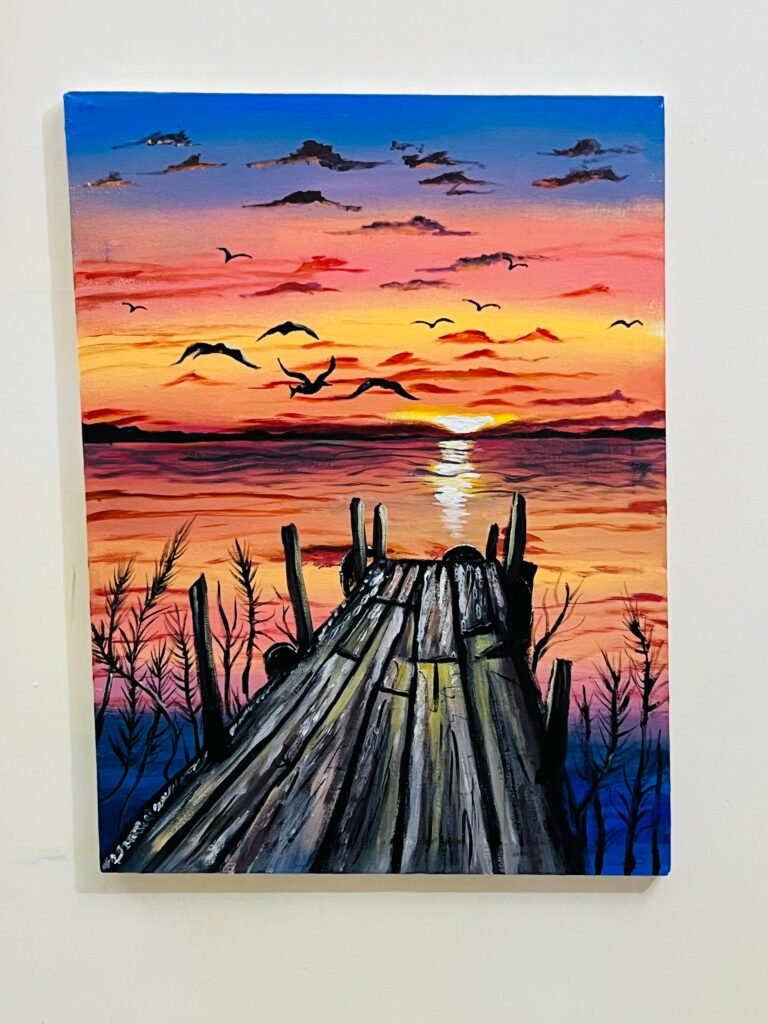Table of Contents
Introduction
Sunsets have a magical allure, captivating anyone who takes a moment to watch the sky transform into a canvas of vibrant colors. As an artist, capturing the beauty of a sunset on canvas can be a rewarding experience. In this tutorial, I’ll walk you through how to paint sunsets, focusing on a serene dockside scene with birds flying gracefully in the sky. This guide is designed with both beginners and experienced painters in mind, so whether you’re new to acrylics or looking to refine your skills, you’ll find valuable tips here.
Why Paint Sunsets?
Sunsets offer an incredible range of colors, from warm oranges and yellows to cool purples and blues. This variety allows for creative freedom and expression in your art. Additionally, sunsets evoke emotions and tell a story, making them a popular subject in landscape painting.
For beginners, learning how to paint sunsets can be an excellent way to explore blending techniques and color theory. For more experienced artists, sunsets offer the challenge of capturing light and atmosphere in a way that feels both realistic and dreamy.
Materials You’ll Need

Before we dive into the step-by-step tutorial, let’s gather the materials you’ll need:
- Acrylic paints: Red, yellow, blue, white, black, and any additional colors for blending.
- Canvas: I recommend an 18×24-inch canvas for this project, but any size will work.
- Brushes: A range of brush sizes, including a flat brush for the background, a round brush for details, and a fine liner brush for the birds.
- Palette: For mixing your paints.
- Water: For cleaning your brushes.
- Paper towels: For wiping excess paint from your brushes.
- Easel: Optional, but helpful for keeping your canvas at a comfortable angle.
Now that you have your materials ready, let’s begin our sunset painting tutorial.
Step 1: Preparing the Canvas
Start by preparing your canvas with a thin layer of white acrylic paint. This will help the colors you apply later blend smoothly. If you prefer, you can also use a light blue or gray as an undercoat, which can add depth to your sky.
Why This Step is Important
Preparing the canvas ensures that the surface is smooth and primed for the layers of paint that will follow. This is especially important in a sunset painting, where smooth transitions between colors are key.
Step 2: Painting the Sky
The sky is the most important element when learning how to paint sunsets. Begin by mixing your paints to create a gradient from the warm hues near the horizon to the cooler tones higher up.
- Start at the Horizon: Use a flat brush to apply a mix of yellow and a touch of red near the horizon. This will be the brightest part of your sunset.
- Blend Upward: Gradually blend in more red as you move upward, then transition into purple, and finally blue at the top of the canvas. Use a clean brush to blend the colors where they meet, creating a seamless gradient.
- Add Clouds: Mix a bit of black with your red or purple to create shadows for the clouds. Use a round brush to dab in cloud shapes, focusing on areas where the colors transition. You can add highlights to the clouds with a bit of white mixed with the sunset colors.
Tips for Painting the Sky
- Work Quickly: Acrylic paints dry fast, so it’s important to blend your colors while they’re still wet.
- Layering: Don’t be afraid to layer colors to achieve the depth and vibrancy you want. If the first layer isn’t as bold as you’d like, let it dry and add another.
Step 3: Painting the Water and Dock
Now that your sky is complete, it’s time to move on to the water and dock in your seascape sunset painting.
- Reflect the Sky in the Water: The water should mirror the colors of the sky. Use the same colors you used for the sky, but darken them slightly by adding a bit of blue or black. Use horizontal strokes with a flat brush to create the appearance of water.
- Paint the Dock: Use a mix of brown, black, and white to create the weathered wood of the dock. Start by blocking in the shape with a flat brush, then use a fine liner brush to add details like the wood grain and shadows.
Tips for Painting Water
- Use Horizontal Strokes: This helps mimic the natural movement of water.
- Create Reflections: Don’t forget to reflect the birds and the dock in the water for a more realistic look.
Step 4: Adding Birds in Flight
Painting birds in flight adds life and movement to your sunset painting. Here’s how to paint them:
- Use a Fine Liner Brush: Start by painting the bird’s body with a small stroke of black paint. Then, add the wings using curved strokes.
- Vary the Size: To create a sense of depth, paint some birds smaller and others larger. This makes it appear as though some birds are closer to the viewer and others are farther away.
- Place the Birds Wisely: Think about composition. Place the birds in a way that guides the viewer’s eye through the painting, creating balance.
Tips for Painting Birds
- Practice First: If you’re not confident in your ability to paint birds, practice on a scrap piece of paper before adding them to your canvas.
- Keep It Simple: The birds don’t need to be highly detailed. Simple, graceful shapes are often more effective.
Step 5: Finishing Touches
The final step in how to paint sunsets involves refining your painting and adding any final details.
- Add Highlights and Shadows: Use a small brush to add highlights to the dock and water, enhancing the contrast between light and shadow.
- Detail the Sky and Water: If you feel the sky or water needs more depth, add additional layers of color or adjust the blending. Sometimes, small adjustments can make a big difference.
- Check the Overall Composition: Step back from your painting to get a sense of the overall composition. Make sure everything feels balanced and that the elements of your painting work together harmoniously.
Conclusion: Embracing the Art of Sunset Painting
Learning how to paint sunsets is a rewarding experience that can improve your skills as an artist. By focusing on techniques like color blending, layering, and adding fine details, you can create a beautiful sunset scene that captures the magic of the moment. Whether you’re a beginner exploring acrylic painting or a more experienced artist looking to expand your repertoire, this sunset painting tutorial offers valuable insights to help you on your creative journey.
Remember, the key to mastering sunset paintings is practice and experimentation. Don’t be afraid to try different color combinations or add unique elements to make the painting your own. With each sunset you paint, you’ll gain more confidence and skill, bringing you closer to your artistic goals.
So, gather your materials, set up your canvas, and start painting. The world of sunset art is waiting for you to explore!

Pingback: best Sunset Painting with Silhouettes: A Tropical Boat Scene - akartisticvision.com3